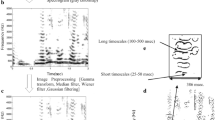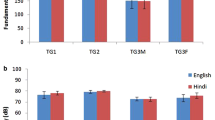Abstract
Indian children represent a unique population of bilinguals who learn two or more languages of different isochrony. Most of their native languages are syllable-timed, whereas in school the language of learning is English, which is a stress-timed language. Exposure to multiple languages with different types of rhythmic patterns as stimulus during the development stage differentiates these children from monolinguals acquiring rhythms of a single language. Thus, to partially fill this gap, a comparative study in 115 children (aged four to eight years) and 18 adults was carried out. We investigated the frequencies around the pitch and first formant which encodes prosodic information in speech. It was found that the harmonic content in speech increases even after four years (where children exhibit or possess intelligent speech) and the spectra of adults were more distributed and had more peaks at higher frequencies as compared to the power spectra of children, where energy in higher frequency was less. This study has implications in finding speech abnormalities in Indian children with speech disorders.



Similar content being viewed by others
References
Brice A E 2002 The Hispanic Child: Speech, Language, Culture, and Education. Allyn & Bacon
Plante E M and Beeson P M 2013 Communication and communication disorders: A clinical introduction. (4th ed.). Boston: Pearson
Eguchi S and Hirsh I J 1968 Development of speech sounds in children. Acta Oto-laryngologica 257:1–51
Kent R D 1976 Anatomical and neuromuscular maturation of the speech mechanism: Evidence from acoustic studies. J. Speech, Lang, Hear. Res. 19(3): 421–447
Kent R D and Forner L L 1980 Speech segment durations in sentence recitations by children and adults. J. Phon. 8: 157–168
Smith B L 1978 Temporal aspects of English speech production: A developmental perspective. J. Phon. 6:37–67
Smith B L 1992 Relationships between duration and temporal variability in childrens Speech. J. Acoust. Soc. Am. 91(4): 2165–2174
Smith B L and Kenney M K 1999 A longitudinal study of the development of temporal properties of speech production: Data from 4 children. Phonetica 56: 73–102
Gautam S and Singh L 2017 Development of spectro-temporal features of speech in children. Int. J. Speech Technol. 20(3): 543–551
Hillenbrand J M, Getty L A, Clark M J and Wheeler K 1995 Acoustic characteristics of American English vowels. J. Acoust. Soc. Am. 97(5): 3099–3111
Smith B L, Sugarman M D and Long S H 1983 Experimental manipulation of speaking rate for studying temporal variability in children’s speech. J. Acoust. Soc. Am. 74(3): 744–749
Nordenberg M and Sundberg J 2004 Effect on LTAS of vocal loudness variation. Logop. Phoniatr. Vocology 29(4): 183–191
Huang J and Holt L L 2012 Listening for the norm: Adaptive coding in speech categorization. Front. Psychol. 3: 10
Elowsson A and Friberg A 2017 Long-term average spectrum in popular music and its relation to the level of percussion. In: Proceedings of the 142nd Convension of the Audio Engineering Society
Flanagan J L 2011 Speech Analysis Synthesis and Perception. Springer Science & Business Media
Rabiner L and Juang B H 1993 Fundamentals of Speech Recognition. Englewood Cliffs: PTR Prentice Hall
Statistics L 2013 One-Way ANOVA – An introduction to when you should run this test and the test hypothesis. Laerd Statistics
Paus T, Zijdenbos A, Worsley K, Collins D L, Blumenthal J, Giedd J N, Rapoport J L and Evans A C 1999 Structural maturation of neural pathways in children and adolescents: in vivo study. Science 283: 1908–1911
Bosma J F 1975 Anatomic and physiologic development of the speech apparatus. Nerv. Syst. 3: 469–481
Vorperian H K, Kent R D, Lindstrom M J, Kalina C M, Gentry L R and Yandell B S 2005 Development of vocal tract length during early childhood – A magnetic resonance imaging study. J. Acoust. Soc. Am. 117(1): 338–350
Author information
Authors and Affiliations
Corresponding author
Rights and permissions
About this article
Cite this article
Gautam, S., Singh, L. The development of spectral features in the speech of Indian children. Sādhanā 44, 15 (2019). https://doi.org/10.1007/s12046-018-1028-2
Received:
Revised:
Accepted:
Published:
DOI: https://doi.org/10.1007/s12046-018-1028-2




